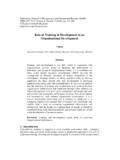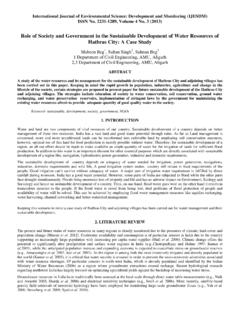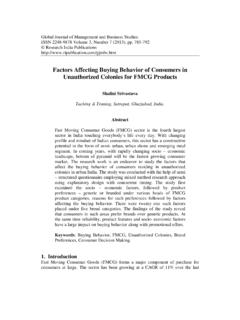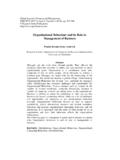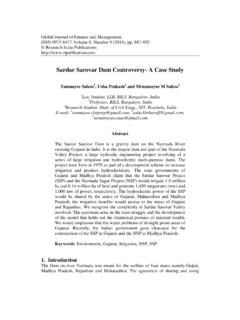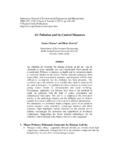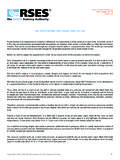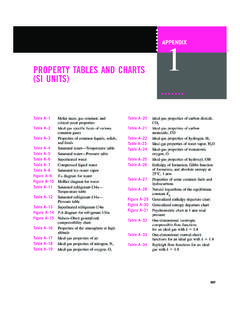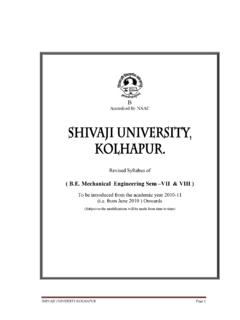Transcription of Design of Cold Storage Structure For Thousand …
1 International Journal of Agriculture and Food Science Technology. ISSN 2249-3050 Volume 5, Number 3 (2014), pp. 171-178 Research India Publications Design of cold Storage Structure For Thousand Tonne Potatoes Priyanka Sakare Department of post harvest process& food engineering, College of technology, Pant University of agriculture & technology, Pantnagar, Uttarakhand, INDIA Abstract Refrigeration has been the principal known method of successful Storage of fresh fruits and vegetables to retain their freshness and flavour. When fruits and vegetables are harvested, they are cutoff from their source of water and nutrition and soon start to deteriorate. They lose weight, texture, flavor, nutritive value and appeal.
2 Both time and temperature are important factors in post-harvest product deterioration .Cooling the harvested product control the rate of quality loss by slowing the rate of respiration. The warmer the temperature, the faster the deterioration and the shorter the Storage life; conversely, the cooler the temperature, the slower the deterioration and the longer the Storage life. The more quickly the product is cooled, the longer it will remain marketable. This paper deals with different aspects of Design of cold Storage and includes all standard refrigeration principles and heat load factors which are normally considered in a cold Storage Design . This Design is hypothetically intended to serve as a guide for future fabrication and erection.
3 Keyword: refrigeration, refrigeration principle, heat load, Design 1. Introduction Storage is the art of keeping the quality of agricultural materials and preventing them from deterioration for specific period of time, beyond their normal shelf life. cold Storage Control ripening retards aging, softening, texture and color change, retards moisture loss, wilting, microbial activity, spoilage, sprouting and undesirable growth. Availability of proper cold storages are important for preserving perishable commodities like milk, meat, eggs, vegetables, fruits, ornamental flowers and other 172 Priyanka Sakare floricultural goods. These cold storages give perishable food items a longer shelf life by preventing them from rotting due to humidity, high temperature and micro-organisms.
4 This results in a decrease in loss due to spoilage. Potatoes are an important staple food crop and have a wide range of seasonal adaptability. It is a cool season crop and is moderately frost tolerant. Temperature during the growing season has long been recognized as one of the most important factors influencing yield. Young plants grow best at a temperature of 24 C; later growth is favored at 18 C. Tuber production reaches a maximum at 20 C, decreases with rise in temperature, and at about 30 C tuber production stops entirely. Short days are beneficial for tuber production. Required temperature, relative humidity and Storage period for early crop, seed potato and table potato are given in table-1 Table-1 Storage conditions of potato Fresh Potato Temperature Storage Period Relative Humidity Early Crop 4 10 C 0 3 months 95% Seed Potato 3 C 5 10 months 90 95% Table Potato 4 C 5 10 months 90 95% 2.
5 Principles of Refrigeration The cold Storage like every other refrigerating systems of the same magnitude employs the vapour compression method of mechanical refrigeration. presents the T-s diagram of the vapour compression cycle, while the illustrates the processes of the refrigeration employed in the cold room, respectively [2]. T-s diagram of the vapour Fig. 2. Processes of the refrigeration compression cycle 3. Design Procedure Heat load factors normally considered in a cold Storage Design Wall, floor and ceiling heat gains from solar radiation due to conduction Load due to ingression of air by frequent door openings and during fresh air charge. Design of cold Storage Structure For Thousand Tonne Potatoes 173 Product load from incoming goods and heat of respiration from stored product Heat from workers working in the room Cooler fan load, light load, aging of equipment Miscellaneous loads, if any Heat load calculations cold Storage for capacity 1000 tons requires room volume approximately 4000 m3 because nearly 50-60 % of the total volume is utilized for Storage purpose.
6 For this purpose one room of size 18m X 15m X 10m (2700 m3) is considered. Structural heat gain: It constitutes the heat transmission into the cold store through wall, ceiling and floor. (a) Heat transmission through walls: - considering walls consisting of cm thick plaster, 37 cm thick brick, cm thick plaster, 10 cm thick thermocol, and cm thick plaster, from outer to inner surfaces respectively. The Storage temperature for potato is kept 5 C and outside temperature is taken 45 C. Heat flow per m2/hour = U (tout tin) = (45-5) = kcal/hour, Wall area = 660 m2, Heat flow through walls = 660 X = kcal/hour = TR (b) Heat transmission through ceiling: - considering ceiling consisting of 3mm thick asbestos sheet and 10 cm thick thermocol.
7 From equation (1)- U=114+ + +115= kcal/m hr C Heat flow per m2/hour = 10 kcal/hr, wall area = 270 m2, Heat flow through walls = TR (c) Heat transmission through floor: - Considering floor consisting of 6cm thick sand, 10cm thick rubble filling, 8cm thick cement concrete, 10 cm thick thermocol and 1 cm thick cement plaster. From equation (1) U=114+ + + + + +115= kcal/m h C Heat flow per m2/hour = kcal/hour, Heat flow through walls = 2592 kcal/hour = TR 174 Priyanka Sakare (d) Heat transmission through door: - Door is made up of sheet with thermocol insulation are taken. Size of the door is X m. Average air changes per hour for 2700 m3storage room due to door opening and infiltration is Heat gain,Q=room volume air changes per hour air density enthalpy change = 2700 (40-3) = kcal/hr = TR Equipment load :- (From lighting, evaporators etc.)
8 Here it is assumed that 10 KW is required for this purpose so the equipment loads= 10 860/3000 = TR Cooling down to freezing point: - Here cp above freezing point for potato is taken Two months are taken for harvesting and during this period 1000 Tonne potatoes are to be stored, hence daily loading rate will be 20 Tons / day. It is assumed that potato is cooled for 24 hours Initial cooling=20 1000 (45 5)24 3000= Heat evolved in Storage : - The heat evolved in Storage of potatoes at 5 C = 450 kcal/ton/day. Heat evolved=1000 45024 3000= Heat of respiration: - Assuming respiration rate 10 KW/ ton (taking average value). Heat of respiration= 1000 10 860/3000= Human occupancy: - Assuming number of occupants working in cold Storage be 3 and working for 10 hours in a day.
9 The amount of heat dissipated by them is 430 kcal/hour (each). Hence heat load due to human occupancy is given by- =3 430 1024 = kcal/hr = Hence, Total TR = + + + + + = TR. Assuming 10-15 % more of calculated TR to be the heat load. Therefore, Total TR = 30 TR. 4. Design of Component Of cold Storage For ammonia used as refrigerant Ideal vapour compression cycle The following values and parameters specified below were selected from the psychrometric chart of the refrigerant, ammonia for the operating pressure range of bars to bars Design of cold Storage Structure For Thousand Tonne Potatoes 175 Table-2 Saturated properties of ammonia S4 = Kcal/kg K, S1 = Kcal/kg K, S3 = Kcal/kg K, S2 = Kcal/kg K h2 = kcal/kg, h3 = kcal/kg, h1 = kcal/kg, h4 = kcal/kg Refrigerant is superheated by 5 C; therefore temperature T1 will be -15 C (or 258 K).
10 Since entropy at point 2 will be same as entropy at point 1, therefore equating both the equations- Cp for ammonia = Kcal/Kg K Equation (2) = Equation (3) S2 = + ln(T2/313), S1 = + ln(258/253) Temperature of refrigerant leaving the compressor, T2= 420 K., S2= + ln(420/313) = kcal/kg K Calculation of COP COP=refrigerating effectwork done=h h h h h3 = h3 Cp (T3 -T3) = (313-310) = kcal/kg = h4 h1= h1 + Cp (T1-T1 ) = + (258-253) = Kcal/kg h2 = h2 + Cp (T2-T2 ) = + (420 313) = Kcal/kg COP =h h h h = Horse power required=capacity in TR 3000 COP 630 Taking 20% more of the calculated HP = 50 + X 50 = 60 HP. 6 set of compressors 10 HP each should be used, including one standby. Refrigerating effect=(h h )=( )= kcal/kg Mass low rate(MFR)=TR 50refrigerating effect=30 Design of compressor Specific volume of ammonia at point 1 or while entering the compressor = m3/kg (from table) 176 Priyanka Sakare Volume flow rate of refrigerant = MFR X specific volume = 400 X = m3/hr Assuming volumetric efficiency to be 80%, Actual displacement=theoretical displacementvolumetric ef iciency= /hr This volume is to be divided into 6 sets of compressor each having 2 cylinders and running at a speed of 450 rpm.
